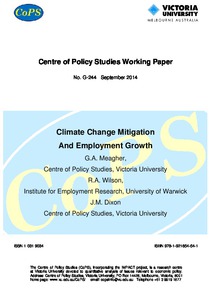Climate change mitigation and employment growth
"Reducing greenhouse gas emissions without reducing economic growth requires advances in technology (which reduce the emissions intensity of industrial production) and/or policy measures to promote structural change (which shift the composition of production in favour of less polluting industri...
| Main Authors: | , , |
|---|---|
| Institution: | ETUI-European Trade Union Institute |
| Format: | TEXT |
| Language: | English |
| Published: |
Melbourne
2014
Victoria University |
| Subjects: | |
| Online Access: | https://www.labourline.org/KENTIKA-19116363124919345459-Climate-change-mitigation-and-.htm |
| Summary: | "Reducing greenhouse gas emissions without reducing economic growth requires advances in technology (which reduce the emissions intensity of industrial production) and/or policy measures to promote structural change (which shift the composition of production in favour of less polluting industries). Moreover, both methods of mitigating the effect of the gases must inevitably proceed in an environment of structural change driven by a variety of other economic forces. This paper introduces new economic modelling which permits an analysis of the effects of mitigation policy on employment that is firmly located within the historical structure of the economy, and within its likely future development in the medium term.
Specifically, the paper investigates the imposition of a tax on the employment of labour by each industry in proportion to the emissions per hour of employment in the industry. In this approach, the extent to which the job of a particular worker can be considered to be 'green' depends on the industry in which he/she works and not on his/her occupation or skill level. The effects of imposing the tax are reported as deviations from the current CEDEFOP medium-term employment forecasts for the European Union. The analysis uses a CGE labour market extension to the macro-econometric E3ME model. The tax is assumed to be returned to producers in such a way that aggregate employment remains constant, so the focus of the analysis is on the structural, rather than the secular, implications of mitigation policy for employment growth.
The model incorporates a detailed description of the structure of the labour market, identifying cross-classified employment in 41 industries, 27 occupations and 3 skill levels. Hence it allows for a comprehensive, cohesive assessment of the economy's requirements for 'green' skills in the sense that it determines which occupations/skill levels expand, and which contract, in response to the mitigation policy. This kind of comparison is important for assigning the appropriate weight to training programs that allocate resources to green skills rather than alternative objectives of educational policy.
The analysis in the paper is restricted to the United Kingdom but the model is designed to provide a suitable basis for comparative-dynamic labour market analyses for all countries belonging to the European Union." |
|---|---|
| Physical Description: | 20 p. Digital |

